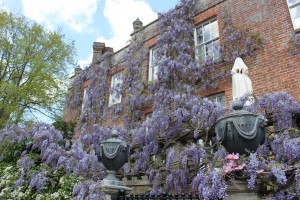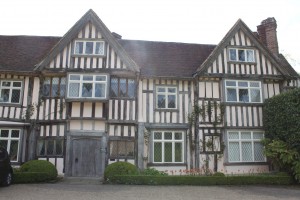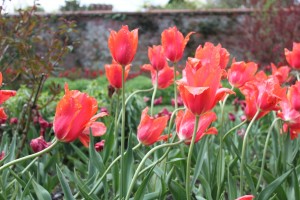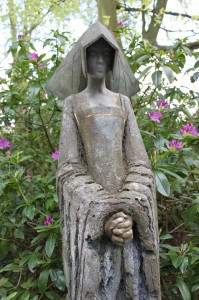Day three of our research trip began with a visit to Hever Castle (more on that soon) and an afternoon sojourn to Pashley Manor in Ticehurst, located on the Sussex and Kent border. Although Pashley Manor is not open to the public, the gardens certainly are and are well worth the visit.
The existing timber framed house is not the home that the Boleyns would have known, as it was built from the mid sixteenth century to the early seventeenth century, and enlarged in c. 1720.
It is believed that the first house built on the site in the thirteenth century, by the Passele family, may well have stood on the island that fills the greater part of the largest of three ponds in the garden, now called the ‘Old Moat’.
In 1452, Sir John de Passhele died ‘seized of Great Pashele in Tysherst’, a description that has given rise to the idea that after the early moated manor, there may have been a more substantial house built on higher land.
This could very well be the house that Sir Geoffrey Boleyn acquired in c. 1453, later passing to his son, Sir William Boleyn. It is believed that Sir Thomas Boleyn held court at Pashley Manor in 1518, however I am yet to find a contemporary source to confirm it.
Local legend has it that Anne Boleyn visited Pashley Manor as a child, not at all impossible considering the proximity to Hever Castle, the Boleyn family home.
Sir James Boleyn inherited the manor after his brother’s death and in 1540 sold it to Thomas May of Combwell. The house was then considerably altered, and in the early seventeenth century it was reconstructed.
Mr and Mrs Sellick are the current owners of the house and have worked tirelessly over the last three decades to restore and enhance the gardens and parkland.
There are a number of sculptures on display in the gardens, including a sculpture of Anne Boleyn by Philip Jackson, made especially to commemorate the link between the Boleyn family and Pashley Manor. I must say that I found the sculpture very moving, especially when viewed from afar.
 We enjoyed some afternoon tea against a stunning backdrop of wisteria, draped over the Georgian front and ambled through the breathtaking gardens. I was overjoyed to get my first glimpse of bluebells after hearing so much about their beauty. Unfortunately, they weren’t at their peak but it was still a lovely sight to behold.
We enjoyed some afternoon tea against a stunning backdrop of wisteria, draped over the Georgian front and ambled through the breathtaking gardens. I was overjoyed to get my first glimpse of bluebells after hearing so much about their beauty. Unfortunately, they weren’t at their peak but it was still a lovely sight to behold.
A quick chat to Mrs Sellick concluded another exhilarating day of research.
On day 4 we ventured to Henry VIII’s Pleasure Palace, Hampton Court, and then on to Carew Manor in Beddington Park.
More pictures from day 3.
[cincopa AIFAL7Kkg3Qg]




















what a wonderful house, and the gardens were beautiful, that wisteria and clematis entwined together looked fabulous…
The statue of Anne looked quite ethelreal and ghost like to me….I think it would make me ‘jump’ if I came across it in near-dark light, but it does have some thing special about it though.
Lovely! I can’t wait for your book as I plan to use it for my tour! Good luck!
I had not heard of Pashley Manor and its connection with the Boleyns. This is fascinating, and your photos are very good indeed. I do envy you your journey back into history.
Enjoyed a lovely sunny afternoon at Pashley Manor. Had not heard about the statues and really loved them and the tree sculptures. My husband enjoyed the strawberry and raspberry Eton mess and me a cup of tea in the tea room. Thoroughly recommend as a well worth trip. Saw the tulips as well on their last day
Didnt get to see this while i was up in Cley my grandfather was a Pashley his father i think was Henry Nash Pashley the taxidermist not real clear on it as he was born out of wedlock he was born at west bechkam workhouse how ever the Pashleys paid for his schooling he had no contact as a child but did a little later on
Just noticed the chap that did anne Boleyns statue was called Philip Jackson its funny as even tho my grandfathers father was a Pashley he was brought up with his mothers maiden name of Jackson so i wonder if it was her brother that did the statue lol